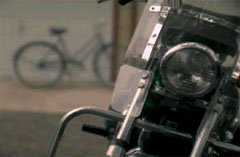| |
Keeping your Subject in Focus
So, with the reduced DOF, how do you keep your actor in focus? As with the other aspects of filmmaking, planning is essential. You "block the shot" by "marking" the actor's starting point in the scene and their ending point. And any stopping points in between. A common way to mark the actor's positions is to make a "T" on the floor with Gaffer's tape where their feet will go. If it a wide shot where the floor will be seen, you might use the corner of a table or other landmark. When you have planned and marked the actor's movement, you get a focus on each of the positions. As the actor moves from one point to the next, you "follow focus".
A device that is invaluable for pulling focus is appropriately called a "follow focus unit". It has a knob that is surrounded by a white marking surface. There is also a gear that has teeth to match the teeth on the focus gear on the lens. When the lens is focused for an actors mark, a pencil or a fine tipped erasable marker is used to indicate the focus point. After the lens is refocused for the second position, the new focus point is marked. Then when the actor moves from the first position to the second, the knob is dialed to the second mark. Care must be taken to dial the follow focus unit so that the second focus mark is hit at the same time the actor hits their second mark. Otherwise, the actor will not stay in focus throughout the take.
When you have a scene with two or more actors and you want to change focus from one actor to another you perform a "rack focus". The technique is the same as above. You mark each focus point and rack focus from one actor to another.
The example footage below shows the micro35 in action, racking focus between the foreground subject and the background subject. This example highlights how all these concepts – shallow DOF, focus, and angle of view - all come together to create a cinema-quality effect.

Rack_Focus.mov (1.98MB)
About the Author
 |
Having begun his visual arts career twenty-five years ago as a still photographer and through the years evolving into the world of cinema, Larry McKee is a multifaceted communicator. Early in his career, his expertise in setting moods and manipulating emotions through lighting and composition led him to serve as technical lighting advisor on shoots for National Geographic Magazine. |
|
Recently however, he has used the motion in television, film and video as his medium of choice. Mr. McKee possesses an intense awareness of the impact that camera angles and the subtleties of camera movement place on the final image produced during a shoot. Additionally, he understands the tools that technology of today offers to the world of cinematic and visual expression. His ability to combine all of the aspects of this medium sets him apart as a more than effective communicator.
Past projects have taken him from the bright lights and glamour of Hollywood to the most remote regions of Russia. Mr. McKee is no stranger to talent as he has worked with the likes of Willie Nelson, Jennifer Lopez, Merle Haggard, Waylon Jennings, Antonio Bandaras, three U.S. Presidents and many others. Several credits include PBS, The Discovery Channel, TNN, and The Outlaw Music Channel. He has put his talents to the test on several documentaries, including one on Elmer Wayne Henley, Jr. He has also served as Director of Photography and Producer on three motion pictures including his latest work with Lunatic Fringe Pictures, "Bitters and Other Natural Remedies". Currently, Mr. McKee acts as producer and resident Director of Photography for the aforementioned Lunatic Fringe Pictures and is a guiding light and focus to any project he takes on. |
|
|
|
|